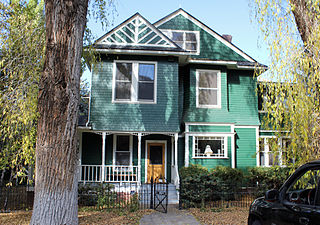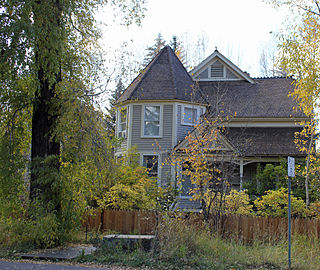
The original Maroon Creek Bridge is a steel trestle along State Highway 82 at the western boundary of Aspen, Colorado, United States. It was designed by George S. Morison in 1888 for the Colorado Midland Railroad, one of the last viaducts in Colorado built for a standard gauge mountain railroad in the 19th century. Of the five steel bridges the Midland built, it is the only one still extant. Due to the later removal of most track and the rail depots, the bridge is the most visible remnant of rail service to Aspen. In 1985 it was listed on the National Register of Historic Places along with other highway bridges in the state, including the Sheely Bridge, also in Aspen.

This is a list of the National Register of Historic Places listings in Pitkin County, Colorado.

The La Fave Block is located at the intersection of East Cooper Avenue and South Hunter Street in Aspen, Colorado, United States. It is a brick commercial building erected in the late 1880s, during the initial mining boom that created Aspen. Today it is the second oldest brick commercial building in the city, and, along with its neighbors on East Cooper, the only structure left built by Frank LaFave, one of Aspen's early settlers. It was listed on the National Register of Historic Places in 1987.

The Wheeler Opera House is located at the corner of East Hyman Avenue and South Mill Street in Aspen, Colorado, United States. It is a stone building erected during the 1890s, from a design by Willoughby J. Edbrooke that blends elements of the Romanesque Revival and Italianate architectural styles. In 1972 it became the first property in the city to be listed on the National Register of Historic Places, and the second in Pitkin County. The upstairs auditorium hosts a number of events every year, ranging from nationally prominent music and comedy acts and some of the Aspen Music Festival's events to productions by local community groups.

The Hyman–Brand Building, often referred to as just the Brand Building, is located at the corner of South Galena Street and East Hopkins Avenue in Aspen, Colorado, United States. It is a two-story stone building erected in the late 19th century. At different stages in the city's history, it was owned by an entrepreneur who used the building in a way that redefined the city for that time. In 1985, it was listed on the National Register of Historic Places.

The Collins Block is a historic commercial building located at 204 South Mill Street in Aspen, Colorado. It is a brick and stone structure erected in the early 1890s.

The Red Onion is a restaurant located on East Cooper Avenue in Aspen, Colorado, United States. It is the oldest restaurant in the city, housed in a three-story red brick Italianate building dating to the late 19th century. In 1987 it was listed on the National Register of Historic Places as "New Brick–The Brick Saloon", along with other historic properties in the city.

The Dixon–Markle House is located at the corner of East Cooper Avenue and South Aspen Street in Aspen, Colorado, United States. It is a wood frame house erected in the 1880s. In 1987 it was listed on the National Register of Historic Places along with other properties in the city.

The former Riede's City Bakery building is located on East Hyman Street in Aspen, Colorado, United States. It is a small wooden commercial building erected in the 1880s. In 1987, it was listed on the National Register of Historic Places.

Pioneer Park, also known as the Henry Webber House or the Webber–Paepcke House, is located on West Bleeker Street in Aspen, Colorado, United States. It is a brick structure erected in the 1880s, one of the few such homes in the city. In 1987 it was listed on the National Register of Historic Places.

The Samuel I. Hallett House is located on West Francis Avenue in Aspen, Colorado, United States. It is a timber frame structure built in the late 19th century. In 1987 it was listed on the National Register of Historic Places.

The Davis Waite House is located on West Francis Street in Aspen, Colorado, United States. It is a wooden structure in Victorian architectural styles built during the 1880s. In 1987 it was listed on the National Register of Historic Places along with several other historic properties in the city.

The Bowles–Cooley House is located at the corner of West Francis and North First streets in Aspen, Colorado, United States. It is a brick structure in the Queen Anne architectural style built during the 1880s. In 1987 it was listed on the National Register of Historic Places along with many other historic properties in the city.

The Thomas Hynes House on East Main Street in Aspen, Colorado, United States, is a wooden building from the 1880s. In 1987 it was listed on the National Register of Historic Places as part of a group of historic properties in the city.

Ute Cemetery, known as Evergreen Cemetery in the 19th century, is located on Ute Avenue in Aspen, Colorado, United States. It is a small, overgrown parcel with approximately 200 burials. In 2002 it was listed on the National Register of Historic Places.

Independence is a ghost town in the U.S. state of Colorado. It is located just off State Highway 82 in the eastern corner of Pitkin County, below the Continental Divide. It was the first settlement established in the Roaring Fork Valley, after gold was struck in the vicinity on Independence Day, July 4, 1879, hence its name. In 1973 it was recognized as a historic district and listed on the National Register of Historic Places as Independence and Independence Mill Site, one of two ghost towns in the county so recognized. It has also been known historically by other names—Chipeta, Mammoth City, Mount Hope, Farwell, Sparkill and Hunter's Pass.

The D.E. Frantz House is located on West Bleeker Street in Aspen, Colorado, United States. It is a wooden frame house constructed for a local lumber magnate during the 1880s in the Queen Anne architectural style. It has remained a private residence ever since and is largely intact. In 1987 it was listed on the National Register of Historic Places along with other historic properties in the city. Included in the listing is a small barn in the back, although the date of its construction is not known.

The Newberry House, also known as the Judge Shaw House, is located on Lake Avenue in Aspen, Colorado, United States. It is a wooden structure in the Shingle Style built around 1890. In 1987 it was listed on the National Register of Historic Places along with other properties in the city.

The Shilling–Lamb House, also sometimes referred to as Victoria House, is located on North Second Street in Aspen, Colorado, United States. It is a wood frame structure in the Queen Anne architectural style built around 1890. In 1987 it was listed on the National Register of Historic Places.

The Smith–Elisha House, sometimes known just as the Elisha House or the Christmas Tree House, is located on West Main Street in Aspen, Colorado, United States. It is a wood frame structure in the Queen Anne style built in the late 19th century. In 1989 it was listed on the National Register of Historic Places.





















